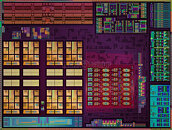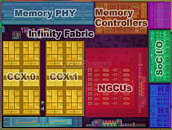Monday, March 16th 2020

AMD "Renoir" Die Shot Pictured
Here is the first die visualization of AMD's new "Renoir" processor. Having made its debut with Ryzen 4000 series mobile processors, "Renoir" succeeds a decade-long legacy of AMD APUs that combine CPUs with powerful iGPUs. AMD designed "Renoir" on TSMC's 7 nm silicon fabrication process. The die measures 156 mm², and has a transistor-count of 9.8 billion. The die shot reveals distinct areas that look like the processor's 8 CPU cores, a cluster of GPU compute units, the integrated memory controllers, southbridge, and PHYs for the chip's various I/O.
"Renoir" features 8 CPU cores based on the "Zen 2" microarchitecture, divided into two 4-core CCXs (CPU complexes). Unlike on 8-core chiplets meant for "Matisse" or "Rome" MCMs, the "Renoir" CCX only features 4 MB of shared L3 cache, probably because latencies to the memory controller are low enough. The L2 cache per core is unchanged at 512 KB. The "total cache" (L2 + L3 on silicon) adds up to 12 MB. The iGPU of "Renoir" is a hybrid between "Vega" and "Navi." The SIMD components are carried over from "Vega," while the display- and multimedia engines are from "Navi." The iGPU features 8 NGCUs that add up to 512 stream processors. Infinity Fabric covers much of the die area, connecting the various components on the die. AMD introduced a new dual-channel integrated memory controller that supports LPDDR4x at up to 4233 MHz, and standard DDR4 up to 3200 MHz.
"Renoir" features 8 CPU cores based on the "Zen 2" microarchitecture, divided into two 4-core CCXs (CPU complexes). Unlike on 8-core chiplets meant for "Matisse" or "Rome" MCMs, the "Renoir" CCX only features 4 MB of shared L3 cache, probably because latencies to the memory controller are low enough. The L2 cache per core is unchanged at 512 KB. The "total cache" (L2 + L3 on silicon) adds up to 12 MB. The iGPU of "Renoir" is a hybrid between "Vega" and "Navi." The SIMD components are carried over from "Vega," while the display- and multimedia engines are from "Navi." The iGPU features 8 NGCUs that add up to 512 stream processors. Infinity Fabric covers much of the die area, connecting the various components on the die. AMD introduced a new dual-channel integrated memory controller that supports LPDDR4x at up to 4233 MHz, and standard DDR4 up to 3200 MHz.


45 Comments on AMD "Renoir" Die Shot Pictured
Frankly, it looks like a remastered SimFarm map.
Dungeon Keeper map view?
www.anandtech.com/show/15624/amd-details-renoir-the-ryzen-mobile-4000-series-7nm-apu-uncovered
No L1 Graphics, but L2 is per WGP, rather than shared. Of the L2, it looks like 2 MB L2.
The bottom thing across the memory phys, looks like a Navi 10/14 command processor.
NGCUs are basically;
Core+L2 SRAM - 0.5MB L3 SRAM - L3 Interface - 0.5 MB L3 SRAM - Infinity Fabric stuff - Another L3 Interface
Also, the thing that is next to it is awkwardly replicated. It kind looks like southbridge I/O.
"Support OpenCL C++ directions and Microsoft's C++ AMP language extension. This eases programming of both CPU and GPU working together to process support parallel workloads."
en.wikipedia.org/wiki/AMD_Accelerated_Processing_Unit#Heterogeneous_System_Architecture
Today some apps use Intel's Quick Sync only.
community.adobe.com/t5/video-hardware/premiere-pro-using-integrated-and-not-dedicated-graphics-card/td-p/9522241?page=1
How is it possible I don't know.
www.asus.com/Laptops/ROG-Zephyrus-G14/
For clarification, the AMD Ryzen 7 4800HS is not a CPU, but an APU with 7 graphics cores.
www.amd.com/en/products/apu/amd-ryzen-7-4800h
You throw something out there, don't back it up and then change the subject matter. :kookoo:
Not to mention that they most probably use single-channel memory out of the box.
It seems like it's single channel, but there's a spare SO-DIMM slot. Supposedly it has 16GB of RAM soldered down.
www.ultrabookreview.com/34951-asus-zephyrus-g14-14-inch-early-review/
In all other instances, it uses its Vega iGPU for hardware acceleration.
I mean this:
www.tomshardware.com/reviews/a10-4600m-trinity-piledriver,3202-16.html
www.tomshardware.com/reviews/opencl-simhd-vreveal,3122.html
We're near D3D13 territory, mesh shaders and ray tracing being the stars, and Vega is not part of it.
And seeing how the current NVIDIA Studio Driver and current Radeon Pro drivers are working well (not in Optimus, of course) in my desktop, I'm sure this configuration would work out just fine.Err.. why not 100W (20V/5A)? PD 3.0 supports this.
But this thing would definitely replace my Dell G5 5587 provided that it is at most $1,399.00.